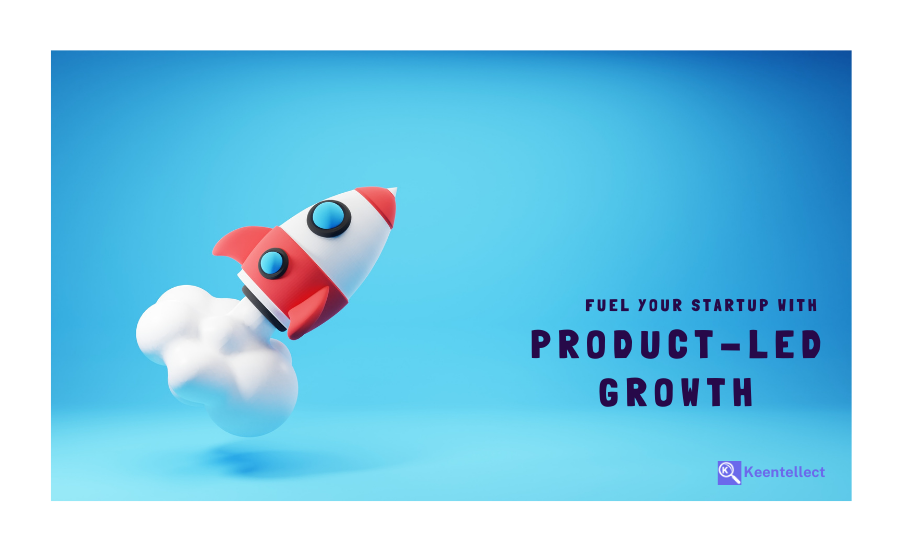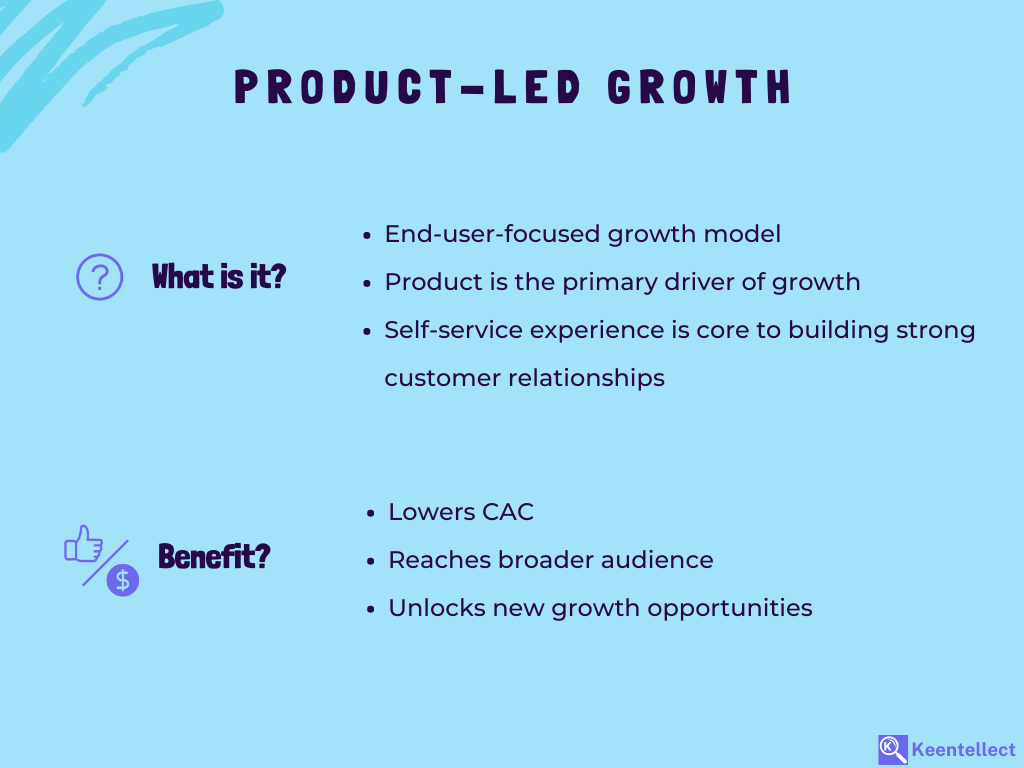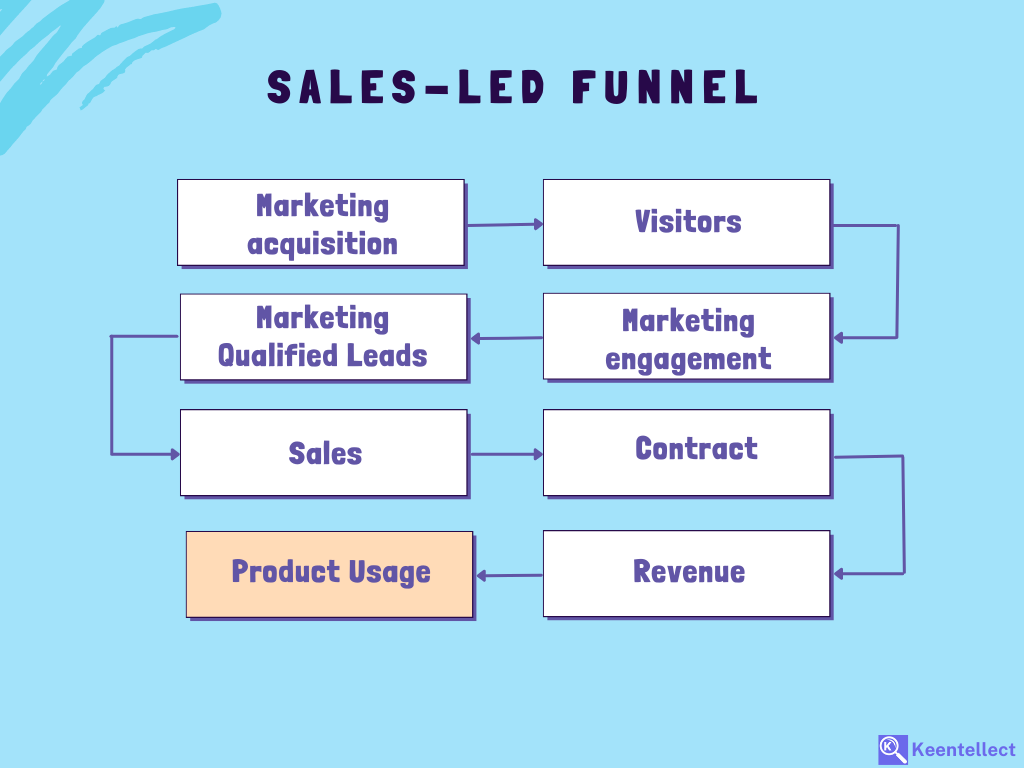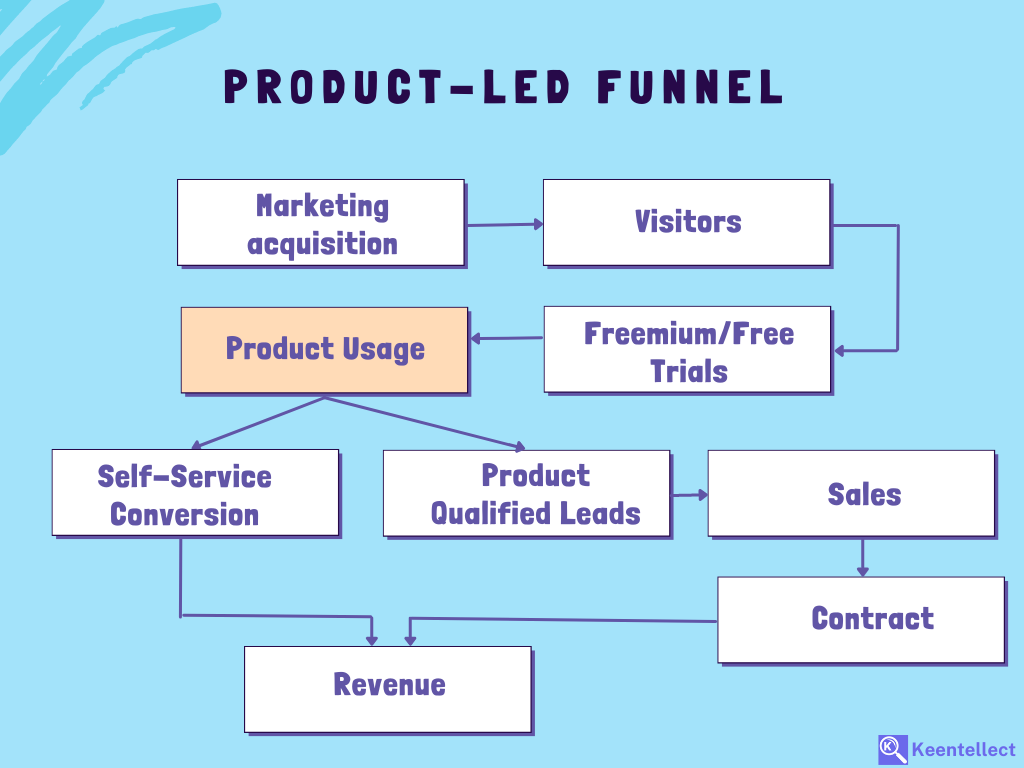Product-Led Growth vs. Sales-Led Growth: Decoding Key Differences in Strategies
 Sugandha Kapoor
Sugandha Kapoor
As a startup founder, I've been hearing about Product-Led Growth (PLG) for some time. I sort of get the gist of it but I haven't had the opportunity to delve into it and gain firsthand experience. In this post, I summarize the basics of this growth model, how it differs from the Sales-Led model, and how to assess if it is a good fit for your product.
What is Product-Led Growth?
Product-Led Growth(PLG) is an end-user-focused growth model that relies on the product itself as the primary driver of customer acquisition, conversion, and expansion.
PLG lowers the barrier to trying a product and reaches a broader audience.

Product-Led growth vs Sales-Led growth
PLG stands apart from the traditional Sales-Led Growth model by placing the product itself as the primary driver of growth.
While Sales-Led Growth relies on sales team involvement and a structured sales funnel, PLG leverages self-service conversion and in-app experiences to drive customer adoption and value realization.
Sales-Led Funnel
For many B2B company websites, the primary call to action is "Book Demo". This would be an example of a company employing the traditional sales-led growth (SLG) model.
A typical workflow for acquiring and converting a new customer in SLG looks something like this:

The marketing team works on adding leads to the top of the funnel by driving traffic to the company's websites.
Visitors can either directly book a call to the demo, fill up a form to request more information, or further engage with the marketing materials such as downloading a white paper, signing up for a webinar, etc. As they interact with marketing materials, they are assigned points for each interaction. When the cumulative points of a lead are higher than a threshold, they qualify as an MQL or Marketing Qualified Lead.
The sales team then engages with the MQLs and works on closing the deal by showing them demos, answering questions, convincing them of the ROI of the product, and so on. Once the deal is closed and the contract signed, customers can use the product. There is often an onboarding call that helps customers to get started and walks them through the product.
Product-Led Funnel
An increasing number of B2B companies are now offering freemium/free trials of their products. Users can simply sign up and engage with the product before deciding to purchase it. This would be an example of a company employing PLG as its growth model.
A typical workflow for product-led growth is looks something like this:

The marketing team still works on adding leads to the top of the funnel by driving traffic to the company's websites. However, in this model, their efforts are often complemented by the product itself. For example, the product often has viral loops built into it, encouraging existing users to invite others and spread the word.
Visitors can directly sign up for the product for free and engage with it. Their onboarding is often assisted with in-app tutorials, knowledge bases, how-to guides, etc. The primary idea is for the user to get the value of the product quickly.
From here on, there are two possibilities for users to convert to paid customers:
Self-service conversion: Users can self-checkout and purchase the product. The price point for this is usually low and it fits easily in most teams' budgets.
Sales-led conversion: As users are engaging with the product, each action earns them certain points. Once the cumulative points of a user surpass a threshold, they are considered a Product-Qualified Lead. At this point, the sales team gets involved and attempts to upsell or cross-sell services to them based on their specific requirements and usage. This approach is known as Product-Led Sales. The price point for this is usually higher. These are bigger deals that benefit from having the sales team involved so these customers can get a white glove service.
So, the growth models of traditional sales-led funnels and product-led funnels differ in their conversion paths, sales team involvement, and user interactions with the product.
Why is it important to understand the differences?
Today, most successful companies leverage both models. They start with one and add the other later.
Understanding the differences in these models is vital in shaping the product, tracking relevant data, and setting up the necessary teams and infrastructure for success. This understanding helps teams ensure compatibility and a harmonious balance between the two approaches.
Strategic reasons for implementing PLG
The next question is which growth model, to begin with. The answer lies in the kind of product you are building.
Sales-led growth is often a good starting point for products that target enterprises. For such products,
There are multiple stakeholders in the buying decisions, the sales cycle is long but the deal size is large
The product is fairly complex and often needs customizations and configurations for different customers
It takes time and assistance for the customers to get started and experience the product value - maybe a couple of weeks. Customers also often expect white-glove service as the deal size is large.
An example of this would be CRM software such as Hubspot or Salesforce.
However, it is important to note that now companies like Hubspot are also layering on PLG to target a wider audience.
You should consider starting with Product-led growth if your product is primarily targeting bottom-up SaaS. Few of the characteristics of the types of products that are a good fit for PLG:
Low product friction- A product that is relatively low in complexity and doesn’t require a lot of customization for the users to see its value.
Quick time to value- Time to value for the end users is relatively short.
Product Virality- A strong viral potential that incentivizes and makes it easy for users to invite others - (💡 Think Zoom and Dropbox)
Network effects-Product has strong network effects i.e. it becomes more valuable as more users join in - (💡 Think Slack)
Users influence buying- Users have direct buying power or have influence over buying decisions (💡 Think Figma)
Product-led growth is often synonymous with viral, freemium, and bottoms-up sales. But it’s much more than that. It is an investment and similar to any other investment, you should have a valid strategic reason for it.
You may need to spend some time analyzing if PLG is a strategic fit for your business. If yes, then realistically be prepared to invest at least a year or two in its roadmap, team, and infrastructure to reap the full benefits of the PLG motion. Here are some of the strategic reasons for going the PLG route:
Improve Efficiency: PLG can lower CAC and improve marketing and sales efficiency. This is one of the primary reasons many established SLG companies are layering on PLG.
Unlock Growth: PLG helps to reach more people and grow into new segments, especially SMBs.
Disrupt established players: Freemium/Free Trials that are integral to PLG can be used to compete with and disrupt established incumbents in your target market. An example of this would be Figma disrupting Adobe.
Defend your position: An established sales-led enterprise product may want to test PLG to defend its position in the market and keep the new entrants at bay.
PLG fit: Your product is a natural fit for PLG
Conclusion
In conclusion, Product-Led Growth (PLG) offers a customer-centric approach that empowers startups to reach a broader audience and drive growth through their product. By focusing on self-service conversion, in-app experiences, and quick time-to-value, PLG lowers barriers and fosters a friendly, user-driven journey. Whether you're disrupting established players or defending your market position, embracing PLG strategically can improve efficiency, unlock new growth opportunities, and can be a useful tool in your armor.
Ultimately, understanding the dynamics of Product-Led Growth empowers you to make informed decisions, design effective growth strategies, and capitalize on the potential of a product-centric approach to drive your startup's success.
See you in the next blog, until then Happy Learning 🚀✨!
Resources
This post is a summary of my takeaways from these awesome resources:
Five steps to starting your product-led growth motion by Hila Qu
Product-Led Growth Strategy for Product Managers by Product School
Original Cover Image Credit: Photo by Andy Hermawan on Unsplash
Subscribe to my newsletter
Read articles from Sugandha Kapoor directly inside your inbox. Subscribe to the newsletter, and don't miss out.
Written by

Sugandha Kapoor
Sugandha Kapoor
Founder | Product Manager | Builder